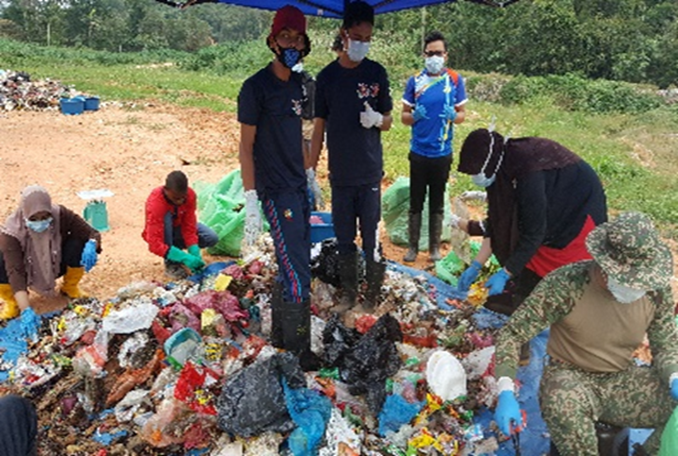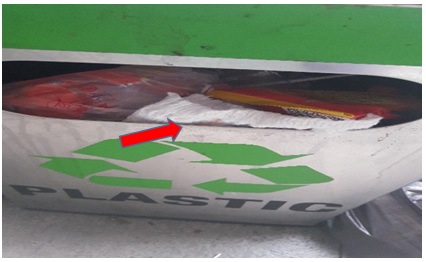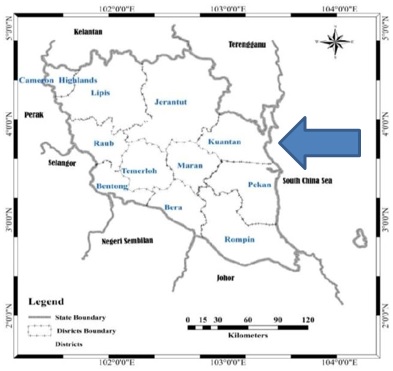Abstract
In Malaysia, two critical issues are identified in waste management: (i) lacking of readiness towards recycling and (ii) segregating. If not properly managed, it leads to massive waste generation at the landfill. Uncontrollable massive waste generation in landfill has various negative impact towards the community. For this reason, this project aims to investigate the household readiness towards waste segregation in one of the cities in Malaysia, Kuantan. The project employs 364 houses for sampling, but only 283 give the response and are willing to participate in this project. This project has two main findings: i) waste generation for each residential area, and statistics on readiness of household towards waste segregation. In conclusion, this project anticipates that only very few numbers of households that are participating in waste segregation. This situation reflects the current scenario in Malaysia. This number only came from one of the cities in Malaysia. With this limited study within limited area of research, this project notes that lacking of readiness would not help the government, or related agencies to make it success of waste segregation project. In fact, this project is crucial for the purpose of sustainable development goals.
Keywords: Recyclelandfillwaste segregationreadinessMalaysia
Introduction
Malaysia, with an area of 330,803 km and has a population of approximately 32,344,164 as of March 27, 2019 (Malaysia Population, 2019). Malaysia has three distinct ethnic groups Malays, Chinese, and Indians. It describes that Malaysia’s number population is on rise and has diversity in culture. This scenario indicates that Malaysia has variety of food consumption and lead to variety waste generation.
Recent report notes 55% of solid waste disposed at landfills comprise food (Bernama, 2018). In number, Malaysian generated average of 38,000 tons of solid waste daily and out of these 38000 tons, only 24% were recycled meanwhile 76% went to landfill (Lim, 2018) and estimated to continue increase by the year 2020. These statistics reveal that the behaviour of recycling and segregating are connected. It tells that if the households do recycling; it indicates that the household is doing waste segregation. However, if these two behaviours (recycling and segregating) do not exist, hence, leads to massive waste generation in landfill.
Research Background
Based on the report, recycling rate is only 17.5% in 2017 (The Star Online, 2017), that is far behind from other developed countries (they are reaching more than 40% (The Sun Daily, 2015). Even the value is quite small (17.5%), it shows that community start to react positively towards government initiatives. (The Star Online, 2017). Vice versa, at most 70% to 80% of recyclable items found in the landfill (Moh & Manaf, 2014). A research conducted in northern Malaysia showed that more than half of household (the respondents) are not interested to participate in recycling activities, the most given reason they did not participate was how ‘inconvenient it was’ (distant, no facilities provided, not important to do recycling) (Omran et al., 2009). Surprisingly, numbers of household revealed that recycling is kind of wasting behavior (Omran et al., 2009). Above findings, showing only small supports received from Malaysia community on recycling and segregating the waste.
This project anticipates that Malaysian do not want to participate due to several reasons:
their attitude, or
culture, or
not much exposure received on recycling, or
not much reading on the aspect of recycling
Not much information on recycling and segregating is shared via internet or physical method.
The above scenario does not help to solve the Malaysia environment issues, as above mentioned it generates massive waste in the landfill. From the statistic view, Malaysia community disposed about 60% waste in a landfill and currently, more than half of the available landfills has reached to maximum capacity (Ghazali et al., 2014; Johari et al., 2012). There are two types of landfill in Malaysia, sanitary and non-sanitary. Sanitary landfill very helpful and useful, but we have very few of its (see Table
In non-sanitary or open dumping landfill, not all waste is pre-treated (Hassan et al., 2006; Visvanathan et al., 2005). Apparently, these two landfills: 1) non-sanitary and 2) open dumping landfill are public known in our country (Idris et al., 2004; Latifah et al., 2009). However, these landfills may contribute to CO2 gas emission and leachate (Hassan et al., 2006). For instant, in 2006, the issues of contaminated drinking water in Klang Valley forced many government agencies to get involved in waste management system. As a result, government builds more sanitary landfills and strictly forbidding opening new dumps (Fauziah & Agamuthu, 2012).
The above discussion extracted three issues: 1) recycling rate is increasing but at a slow pace, 2) limited number availability of landfill, 3) Pre-treated of waste due no segregation from source. A proper waste segregation behaviour helps tackle those three issues, however, Malaysia is still lacking in terms of exposure on information related to waste segregation processes including “what, how, why questions.
On top, government also has played its role such as launching the campaign of waste segregation among the households and introduced the act on Solid Waste and Public Cleansing Management Act 2007 (Act 672) and it becomes mandatory in September 2015. The government provides only for residents in urban area but not in rural; the rural residents still dispose the waste illegally by open air burning and open dumping (Moh & Manaf, 2014).
Nevertheless, waste separation practice by public in Malaysia is still low and still in tradition waste handling: scavengers do the most the waste segregation in landfill site. The entire problem of the waste separation comes from the public where Malaysia still far behind in terms of cognitive awareness towards hygiene, to have empathy, responsibility towards change behavior that involves waste self- management (Moh & Manaf, 2014). Thus, it is important to investigate the readiness behaviour of Malaysian towards waste segregation.
Problem Statement
As noted in previous discussion, the average for waste generation rate is from 0.8kg/cap/day – 1.12kg/cap/day and the recycling rate increasing from 5% to 17.5%. The worry point is the i) waste dumped in landfill is increasing yearly and ii) Malaysia has 155 landfills, but only 12 of them are sanitary landfills. Due to using an over capacity landfill, the methane (CH4) and Green House Gases (GHG) emissions are increasing.
This scenario describes that Malaysia faces crucial environmental problem and needs a better solution and implementation in immediate time. The local authorities and decision makers at state level had discussed with the various stakeholder to figure out the right policies and strategies for implementation programs. Malaysia waste authorities had carried out massive effort to reduce the waste generation and as a result recycling rate increases to 17.5%. However, this figures - not enough to solve the critical problems of landfill in Malaysia.
Consumer, society, community play a major role in helping reducing waste generation in Malaysia however, they may not work hard on it and this practice of waste segregation is still considered poor among Malaysian. For example, more than 30% potentially recyclable materials were directly disposed in the landfills. Recently, a field study conducted in one of the landfill located in Pahang, Malaysia. The study found out that the landfill comprised of combination waste: domestic waste and recyclable See below.

As shown in Figure

The design for dustbin in figure
As the outcome, the correct waste segregation helps to minimize waste generation, but the consumer needs to be in ‘ready’ state. Hence, this project aims to investigate the readiness of household towards waste segregation, providing existing government regulations, facilities and knowledge on waste management.
Research Questions
RQ: What is household reaction towards issue of massive waste generation in landfill?
RQ a: What is the measurement of waste generation among households?
RQ b: How ready of household towards segregating their waste?
Purpose of the Study
This project aims to investigate the readiness of household towards waste segregation and develop two objectives:
1. To weight household waste generation
2. To observe whether the household is engaged with waste segregation behaviour or not (to see either the household separate or not the waste (between wet n dry).
Research Method
Description of Study Area

Kuantan has been selected for the preliminary study because of its high population density due to the urban development and industrial areas. Kuantan population is approximately 607,778. This particular study focuses on households in Bandar Indera Mahkota, Kuantan, Pahang with population approximately 11,712
Data Collection
In the data collection process, there were four residential area are identified: 1) Indera Mahkota 1, 2) Indera Mahkota 2, 3) Indera Mahkota 8, and 4) Indera Mahkota 15. These four residential areas were selected due to its greater number of population. A total of 364 houses were selected from this 4 residential area. This project employs scattered random sampling (see Table
This project applies same data collection method to all four residential areas. All teams received analogue weight scales and specific forms for data record purposes. The weighing process is in morning session (from 7.30 am to 12 pm). This period is preferred due to 1) the availability time for most residents and 2) it is best to collect in the morning session due to have a pleasant weather. The data were collected from 283 house (out of 364 houses). This respond due to some houses locate their waste bin inside the house and no one in the house, data cannot be collected from that particular houses.
Findings
-
Waste generation for each residential area
-
Statistics on readiness of household towards waste segregation
First Category
From table
1) Waste generation rate is from 2.23 kg/ day – 4.79kg/ day
2) Approximately only 21% of household were recycle their waste
3) Even only wet waste collection schedule was considered, household that purely ready with segregation still segregating their waste.
Second Category
Table
Conclusion
In conclusion, this project anticipates that very few numbers of households that are participating in waste segregation. It does reflect the current scenario in Malaysia. This number only came from one of cities in Malaysia. With this limited study within limited area of research, this project notes that lacking of readiness would not help the government, or related agencies to make it success of waste segregation project. In fact, this project is crucial to make sure country’s sustainable development goals.
Acknowledgments
This project would like to express our millions thank you to Yayasan Canselor UNITEN (YCU) for sponsoring our project, all communities in Bandar Indera Mahkota and students of International Islamic University Malaysia for their participation and support to our project
References
- Bernama. (2018, October 15). Malaysians throwing away food at alarming rate. The Star. https://www.thestar.com.my/news/nation/2018/10/15/malaysians-throwing-away-food-at-alarming-rate/
- Fauziah, S. H., & Agamuthu, P. (2012). Trends in sustainable landfilling in Malaysia, a developing country. Waste Management & Research, 30(7), 656-663.
- Ghazali, F. M., Syafalni, S., & Noor, S. M. (2014). Public perception on the current solid waste management system in Malaysia: A comparative study of Matang Landfill and Bukit Tagar Sanitary Landfill (BTSL). World Applied Sciences J., 32, 872-883.
- Hassan, M. N., Theng, L. C., Allgaier, G., & Stegmann, R. (2006). Landfilling. In solid waste management in Asia. An e-book of teaching and training modules for higher education in the waste management sector (pp. 165-185). The TUHH Hamburg University of Technology, Hamburg, Germany.
- Idris, A., Inanc, B., & Hassan, M. N. (2004). Overview of waste disposal and landfills/dumps in Asian countries. Mater. Cycles and Waste Management, 6, 104-110.
- Johari, A., Ahmed, S. I., Hashim, H., Alkali, H., & Ramli, M. (2012). Economic and environmental benefits of landfill gas from municipal solid waste in Malaysia. Renewable and Sustainable Energy Reviews, 16(5), 2907-2912.
- Kompendium Pengurusan Sisa Pepejal Malaysia, Edisi 1. 2017. Perbadanan Pengurusan Sisa Pepejal dan Pembersihan Awam (SWCorp).
- Latifah, A. M., Mohd Armi, A. B., & Nur Ilyana, M. Z. (2009). Municipal solid waste management in Malaysia: Practices and challenges. Waste Management, 29, 2902-2906.
- Lim, R. (2018, September 9). Green ways to manage waste. The Star Online. https://www.thestar.com.my/news/nation/2018/09/09/green-ways-to-manage-waste-swcorp-goes-for-green-technology-and-educating-the-young/
- Malaysia Population. (2019). Retrieved from http://www.worldometers.info/world-population/malaysia-population/
- Moh, Y. C., & Manaf, L. A. (2014). Overview of household solid waste recycling policy status and challenges in Malaysia. Resources, Conversation and Recycling 82, 50-61.
- Omran, A., Mahmood, A., Abdul Aziz, H., & Robinson, G. M. (2009). Investigating households attitude toward recycling of solid waste in Malaysia: a case study. International Journal of Environmental Research, 3(2), 275-288.
- Public Cleansing Management Act 2007 (Act 672).
- The Star Online. (2017, August 20). Low awareness on recycling among Malaysians. https://www.thestar.com.my/news/nation/2017/08/20/low-awareness-on-recycling-among-malaysians/
- The Sun Daily. (2015, April 21). Malaysia's recycling rate is still low. https://www.thesundaily.my/archive/1391122-LSARCH305800
- Visvanathan, C., Tränkler, J., Joseph, K., Chiemchaisri, C., Basnayake, B. F. A., & Gongming, Z. (2005). Asian regional research programme on sustainable solid waste landfill management in Asia. Paper proceedings, Tenth International Waste Management and Landfill Symposium, S. Margherita di Pula, Cagliari, Italy; 3 -7 October 2005.
Copyright information

This work is licensed under a Creative Commons Attribution-NonCommercial-NoDerivatives 4.0 International License.
About this article
Publication Date
30 December 2020
Article Doi
eBook ISBN
978-1-80296-099-0
Publisher
European Publisher
Volume
100
Print ISBN (optional)
-
Edition Number
1st Edition
Pages
1-905
Subjects
Multi-disciplinary, accounting, finance, economics, business, management, marketing, entrepreneurship, social studies
Cite this article as:
Muslim, N. A., Hussain, S., Ghani, F. A., Rasli, M. A. M., Omar, S. M., Hamid, A. A. B. A., Sharif, M. F., Majid, M., & Ma’arop, N. F. (2020). A Preliminary Study on Household Readiness to Engage in Waste Segregation Behavior. In N. S. Othman, A. H. B. Jaaffar, N. H. B. Harun, S. B. Buniamin, N. E. A. B. Mohamad, I. B. M. Ali, N. H. B. A. Razali, & S. L. B. M. Hashim (Eds.), Driving Sustainability through Business-Technology Synergy, vol 100. European Proceedings of Social and Behavioural Sciences (pp. 302-310). European Publisher. https://doi.org/10.15405/epsbs.2020.12.05.32

